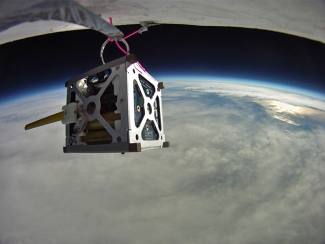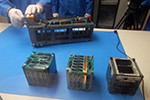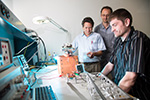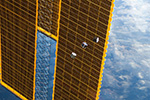
The Small Satellite Research Laboratory is an integrated environment where antennas and communication systems for small satellites can be designed, simulated, fabricated, and tested within a single lab space.
ECE students are both welcomed and encouraged to get involved with the ongoing research projects at the Small Satellite Research Laboratory. Student researchers within the laboratory will be working side-by-side with engineers and scientists from NASA Johnson Space Center with the ultimate goal of transforming small spacecraft technologies.
The Small Satellite Research Laboratory was established in 2013 under the guidance of ECE faculty members David Jackson and Ji Chen. Beginning in fall of 2014, Jackson and Chen will receive up to $200,000 from NASA over the next two years to continue their research within the Small Satellite Research Laboratory. The University of Houston is among only 13 universities chosen by NASA to design and develop new small satellite technologies.
Enhancing the ECE Student Experience with CubeSats
Earth-orbiting artificial satellites are complex engineered systems that provide vital earthbound services, including weather observation, television, telephony, and internet connectivity. Developing and launching a commercial satellite requires a diverse team of engineers to work together towards a common purpose. A budding engineer would consider it the ultimate capstone design experience.
CubeSats can bring a microcosm of this real-world capstone experience to ECE students. A basic CubeSat is a small (~10cm cube) and lightweight (~3 pounds) spacecraft that can be built by student teams at a modest cost (~$5,000). As many of as six cubes can be stacked to build larger satellites. They can be launched into Earth orbit by space agencies for under $100,000.
Thanks to their affordability, academic institutions, ECE students now have unprecedented access to space for education and scientific research. CubeSats have the potential to elevate the ECE Senior Design experience to a new level, and offer the essential ingredients of a great Capstone Design experience.
CubeSats require a variety of sensors, actuators, and embedded computing systems. They bring multiple real-world constraints into play, including size and weight restrictions, energy efficiency, reliability, robustness, and the ability to work in extreme environments. Building a successful CubeSat project brings together a variety of ECE sub-disciplines including sensing, imaging, optics, embedded computing, navigation, communication, and energy harvesting methods. It can also forge new relationships with other departments, notably mechanical and aerospace engineering, the natural sciences, and other institutions. Small companies now offer parts for CubeSats. There is also an emerging culture of open source sharing of subsystem designs and software tools. Finally, CubeSat projects often attract external mentors, and financial sponsorship from corporations and federal laboratories.
News and Multimedia
|
|
|
|
|
NASA-Sponsored Student Team Develops Innovative Small Satellite Antenna Designs |
|
|
|
|
|
|
|
|
ECE Chairman, Faculty, and NASA Collaborators Publish CubeSat Article in “ECE Source” Newsletter |




